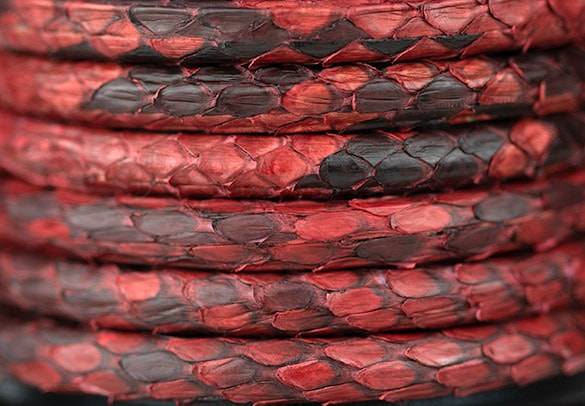Red Python Leather

Exotic Craftsmanship
Python skin is an amazingly pliable and diverse application. The skins are light in weight but very strong and with a distinctly diverse number of colours, tanning options and finishes. Its unique appearance is instantly recognizable, which makes it a great leather to use for applications that will always maintain its luxury appeal despite what is trendy or currently in fashion.
Our Red Python leather is processed in Spain. Quality of this leather, tanned in red colour, transmits a unique elegance to the final product.
No two snakes have the same pattern – nothing in nature or man-made matches the unique scales, patterns, and unique texture of genuine python leather.
Our Red Python skin is unbleached, matte-finished.
Phyton skin is known for prominent natural markings when processed without bleaching (referred to as unbleached). These natural markings form distinct diamond patterns which are more visible.
Matte-finished hides do not have the shine and are softer to the touch with scales that slightly protrude on their edges. The matte finish on a python skin leaves it soft and supple. Because of their softness and pliability, matte skins are the perfect material for bracelets.
Regulations
Our python skins processed in Spain are legally imported through South East Asia and is sourced and processed under ethical practices to ensure sustainability for the environment.
Python skin usually is both farmed and wild-caught by hunters for the meat. The skin is a byproduct.
The global python skin trade is monitored and regulated by governments via the Convention on International Trade in Endangered Species of Wild Fauna and Flora (CITES). Concluded in 1973 (with subsequent entry into force in 1975), CITES is a multilateral, legally binding agreement that aims to prevent the over-exploitation of wild plants and animals through international trade.
The EU is the primary destination of python skins exported from South-East Asia. CITES is implemented in the 27 EU Member States through regulation known more generally as the EU Wildlife Trade Regulations (European Commission, 2012).
The Basic Regulation lays down provisions for the import, export and re-export of wildlife internally within the EU and for specimens originating from/destined for outside the EU; establishes procedures required for trade; regulates movement of live specimens; ensures member states compliance with the Regulation; and enforces sanctions against offending states (European Commission, 2012a).
